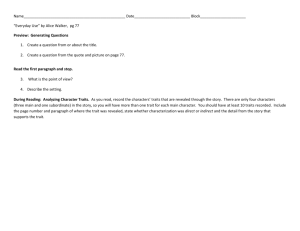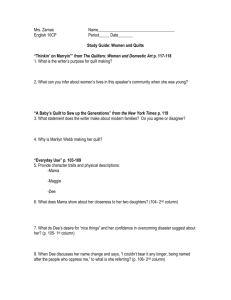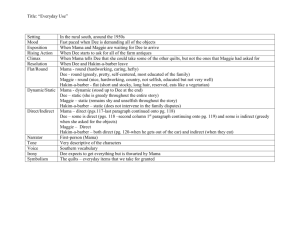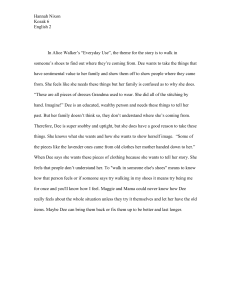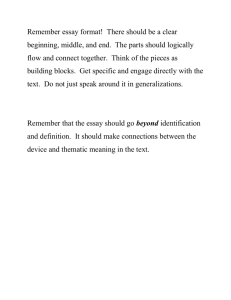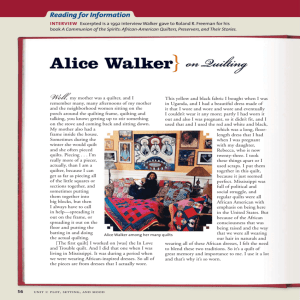"Everyday Use" was published early in Alice Walker's
advertisement
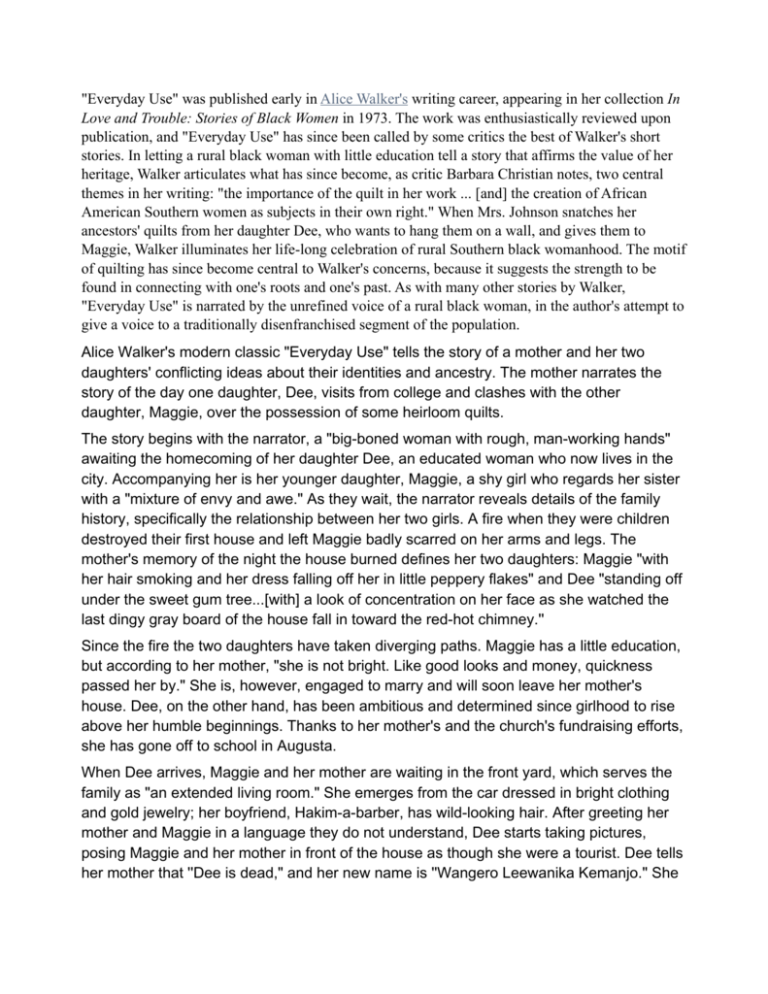
"Everyday Use" was published early in Alice Walker's writing career, appearing in her collection In Love and Trouble: Stories of Black Women in 1973. The work was enthusiastically reviewed upon publication, and "Everyday Use" has since been called by some critics the best of Walker's short stories. In letting a rural black woman with little education tell a story that affirms the value of her heritage, Walker articulates what has since become, as critic Barbara Christian notes, two central themes in her writing: "the importance of the quilt in her work ... [and] the creation of African American Southern women as subjects in their own right." When Mrs. Johnson snatches her ancestors' quilts from her daughter Dee, who wants to hang them on a wall, and gives them to Maggie, Walker illuminates her life-long celebration of rural Southern black womanhood. The motif of quilting has since become central to Walker's concerns, because it suggests the strength to be found in connecting with one's roots and one's past. As with many other stories by Walker, "Everyday Use" is narrated by the unrefined voice of a rural black woman, in the author's attempt to give a voice to a traditionally disenfranchised segment of the population. Alice Walker's modern classic "Everyday Use" tells the story of a mother and her two daughters' conflicting ideas about their identities and ancestry. The mother narrates the story of the day one daughter, Dee, visits from college and clashes with the other daughter, Maggie, over the possession of some heirloom quilts. The story begins with the narrator, a "big-boned woman with rough, man-working hands" awaiting the homecoming of her daughter Dee, an educated woman who now lives in the city. Accompanying her is her younger daughter, Maggie, a shy girl who regards her sister with a "mixture of envy and awe." As they wait, the narrator reveals details of the family history, specifically the relationship between her two girls. A fire when they were children destroyed their first house and left Maggie badly scarred on her arms and legs. The mother's memory of the night the house burned defines her two daughters: Maggie "with her hair smoking and her dress falling off her in little peppery flakes" and Dee "standing off under the sweet gum tree...[with] a look of concentration on her face as she watched the last dingy gray board of the house fall in toward the red-hot chimney.'' Since the fire the two daughters have taken diverging paths. Maggie has a little education, but according to her mother, "she is not bright. Like good looks and money, quickness passed her by." She is, however, engaged to marry and will soon leave her mother's house. Dee, on the other hand, has been ambitious and determined since girlhood to rise above her humble beginnings. Thanks to her mother's and the church's fundraising efforts, she has gone off to school in Augusta. When Dee arrives, Maggie and her mother are waiting in the front yard, which serves the family as "an extended living room." She emerges from the car dressed in bright clothing and gold jewelry; her boyfriend, Hakim-a-barber, has wild-looking hair. After greeting her mother and Maggie in a language they do not understand, Dee starts taking pictures, posing Maggie and her mother in front of the house as though she were a tourist. Dee tells her mother that ''Dee is dead," and her new name is ''Wangero Leewanika Kemanjo." She claims she could not stand being "named after the people who oppress me." Her mother's complaints that "Dee" is an old family name do not register. During the meal Dee reveals her true intentions in visiting: to collect objects for her home that she can use to display her heritage. First she takes the butter churn, which she plans to use "as a centerpiece for the alcove table." After dinner Dee continues to search for objects for her collection and latches on to the quilts that had been made by her mother, grandmother, and great-grandmother. The quilts contain pieces of family history, scraps from old dresses and shirts that family members have worn. One patch is constructed of the girls' great grandfather's Civil War uniform. The quilts, however, have already been promised to Maggie for her wedding. Dee contends that she has a right to them because she understands their value as folk art, declaring them ''priceless.'' Maggie, on the other hand, is prepared to relinquish her rights to them rather than argue with her sister. When Maggie tells her she can have the quilts, because she "can 'member Grandma Dee" without them, the mother knows instantly who is the most deserving. She hugs Maggie, who was "used to never winning anything, or having anything reserved for her," and "snatched the quilts out of Miss Wangero's hands and dumped them into Maggie's lap." After Dee departs without the quilts, Maggie smiles a ''real smile'' for the first time. Everyday Use | Characters Asalamalakim See Hakim-a-barber. Grandma Dee Although Grandma Dee, as the Johnson women call her, does not appear in the story, she is a significant presence. Maggie is attached to the quilts because they make her think of Grandma Dee. Thus, although the woman is dead, she represents the cherished family presence that lives on in Maggie's and her mother's connection to the past. Hakim-a-barber Hakim-a-barber is Dee's boyfriend who accompanies her on her visit back home. Though he has grown his hair long in an African style that identifies him with the black power movement, he refuses to eat collard greens and pork at dinner̶ traditional AfricanAmerican foods. This minor character's name is perhaps his most significant feature. Mrs. Johnson confusedly accepts his black Muslim greeting, "Asalamalakim," as his name, and "Hakim-a-barber" is her guess at the pronunciation of what he tells her to call him. This confusion signals the gap between black nationalist ideas and rural African-American life. Wangero Leewanika Kemanjo See Dee Johnson. Dee Johnson Dee is Mrs. Johnson's oldest daughter; the one who has always been determined, popular, and successful. Upon returning home after escaping her impoverished home life and forging a new identity at college, one which ostensibly celebrates her African heritage, Dee tells her mother that ''Dee is dead," and her name is now Wangero Leewanika Kemanjo. Thus, Dee denies her real heritage, in which she was named for her aunt. Dee's other attempts to appreciate her cultural heritage miss the mark: she wants to display her mother's possessions in her home as examples of folk art but refuses to recognize their greater value to her mother and sister as objects of "everyday use" that they still use. Maggie Johnson Burned severely in a house fire as a child, the shy, stammering Maggie Johnson cowers in the overwhelming presence of her sister. While Dee has moved on to an entirely new life, Maggie still lives in poverty with her mother, putting "priceless" objects to "everyday use." At the end of the story, the quiet, self-conscious Maggie smiles, "a real smile, not scared," because her mother has finally recognized that she, not Dee, is the daughter who understands her heritage and the importance of connecting with one's ancestors. Mrs. Johnson Mrs. Johnson is the narrator of this story, overseeing its events and interpreting, more through her actions than her words, their significance. As she waits for her daughter Dee to return home for a visit, she demonstrates her lack of self-esteem by imagining a much thinner, prettier version of herself meeting her daughter on a television show. Near the end of the story, Mrs. Johnson demonstrates a shift in her maternal sympathies by taking the quilts from Dee and giving them to Maggie, signaling for the reader where the author's own sympathies also lie. Everyday Use | Themes In "Everyday Use," the contrast between Dee's beliefs and those of her mother and sister is emphasized by the different values the characters place on some old quilts and other objects in the home. Heritage The main theme in the story concerns the characters' connections to their ancestral roots. Dee Johnson believes that she is affirming her African heritage by changing her name, her mannerisms, and her appearance, even though her family has lived in the United States for several generations. Maggie and Mrs. Johnson are confused and intimidated by her new image as "Wangero." Their own connections to their heritage rest on their memories of their mothers and grandmothers; they prefer to remember them for who they were as individuals, not as members of a particular race. Because of their differing viewpoints, each values the Johnson's possessions for different reasons. Dee digs around the house for objects she can display in her own home as examples of African-American folk art. Maggie and her mother value the same objects not for their artistic value, but because they remind them of their loved ones. Dee admires a butterchurn, and when Maggie says it was carved by their aunt's first husband̶"His name was Henry, but they called him Stash"̶ Dee responds condescendingly that her sister's memory is like an elephant's. But the story suggests that Maggie's elephant-like memory for her loved ones and her appreciation for their handiwork is a more genuine way to celebrate their heritage than Dee's "artistic" interests in removing these ordinary objects and exalting them as examples of their African roots. Materialism Dee's materialism is demonstrated at a young age when she watches her modest home burn with "a look of concentration on her face." Later, "Dee wanted nice things"̶ particularly clothes̶and was interested in maintaining a style that belied her humble roots. Her mother states that when she sees the new house, a three-room shack with no "real" windows and a tin roof, "she will want to tear it down." Her appearance confirms this trend: she is dressed in elaborate clothes and gold jewelry, Dee's interest in the butterchurn and the quilts is raised because they are "priceless" objects. She wants to possess them as relics and would not think of employing them for ''everyday use." In contrast to Dee's materialism is Maggie's and her mother's pride in their home and their contentedness with life. They have made the front yard "clean and wavy'' in anticipation of her arrival, and the yard is "more comfortable than most people know." Community vs. Isolation The quilts represent the Johnsons' connection to their community. They are formed by patches of clothing from many peoples' clothes, forming a mosaic that represents the past, their loved ones' lives, and their family history. Dee's lack of interest in the people with whom Maggie associates the quilt underscores the story's emphasis on the importance of community. Furthermore, while Dee cannot wait to escape her family's poverty so she can go to college and have nice things, her mother and sister have a clean yard in which "anyone can come and sit and look up into the elm tree." Maggie, despite her shyness, is engaged to be married, showing her ability to connect with another person. Dee, who Maggie suggests has never had real friends, has been jilted by a man who "flew to marry a cheap city girl." By showing the different paths the sisters have taken, Walker suggests that black nationalists such as Dee and Hakim-a-barber, who identify with their African ancestry by rejecting white ways, have cut themselves off from connecting with their backgrounds, which often have not been steeped in African tradition. Dee's apparent embarrassment about her rural roots contrasts sharply with Maggie's heartfelt connection through the quilts to her grandmother. Everyday Use | Style Walker uses several literary devices to examine the themes in the story and to give a voice to the poor and the uneducated. Point of View ''Everyday Use'' is told in first-person point of view. Mrs. Johnson, an uneducated woman, tells the story herself. The reader learns what she thinks about her two daughters, and her observations reveal her astute observations about life. This technique seeks to validate the experiences of an often oppressed group of people: lower-class, black women. By putting Mrs. Johnson at center stage, Walker confirms her value and importance in society. Mrs. Johnson has mixed emotions about her daughters. She likens Maggie's demeanor to ''a dog run over by some careless person rich enough to own a car," and says that Dee's reading ''burned us with a lot of knowledge we didn't necessarily need to know." These conflicting feelings show the reader the complex nature of her thoughts and her ability to size up people when necessary. Her thoughts are compounded further by her fantasy of reuniting with Dee on a television talk show where ''Johnny Carson has much to do to keep up with my quick and witty tongue." Symbolism The story is not only rich in symbolism, it is also about symbolism. The quilts are the central symbol of the story, representing the connectedness of history and the intergenerational ties of the family. Other symbols include Maggie's burned skin, which can be interpreted as depicting how she has been ''burned'' by the circumstances of her Life. Mrs. Johnson's "man-working" hands symbolize the rough life she has hand to forge from the land on which they live. Names become symbolic in the story as well. Dee thinks her name represents "the people who oppress me," and substitutes an African name that has no relation to her family roots. When Hakim-a-barber says that he does not eat collard greens and pork̶traditional African-American foods̶he symbolically denies his heritage despite his complicated African name. Clothing also represents the characters. Mrs. Johnson wears utilitarian clothing: overalls and flannel nightgowns, representing her nofrills approach to life. Dee wears a "yellow organdy dress" to her graduation and other wild, colorful clothing. These outfits represent her colorful, vibrant nature as well as her unwillingness to fit in to her surroundings, a harsh land more suited to farm clothing. Maggie's character is symbolized by the dress that ''[falls] off her in little black papery flakes" during the house fire: fragile and burned. Irony The central contradiction in this story emerges when readers understand Walker's point about Dee's efforts to appreciate her heritage. While Dee has acquired an education and understands her African past, she mistakenly looks to this history in order to affirm her heritage, forgetting her real origins and the people who raised her. She admires the quilts, particularly because her grandmother has sewed them by hand. She is more entranced by the thought of someone sewing by hand than by the person who did the sewing. Diction and Dialect In relating the story in first-person, Walker gives Mrs. Johnson a pattern of speech that helps define her character. An uneducated woman, Mrs. Johnson nonetheless is able to express herself well. She waits in a yard that has been made "clean and wavy," meaning that she has taken pride in her house and fixed it up in anticipation of her daughter's arrival. Walker's subtle rendering of Mrs. Johnson's voice reveals that this older rural woman can also speak with efficient, lyrical clarity, as in her account of having "knocked a bull calf straight in the brain between the eyes with a sledge hammer and [having] had the meat hung up to chill before nightfall," or in her description of Hakmi-a-bar-ber's real name, which is "twice as long and three times as hard" to pronounce. Walker artfully suggests, then, that a "good" education does not necessarily result in a "better" form of speech.



